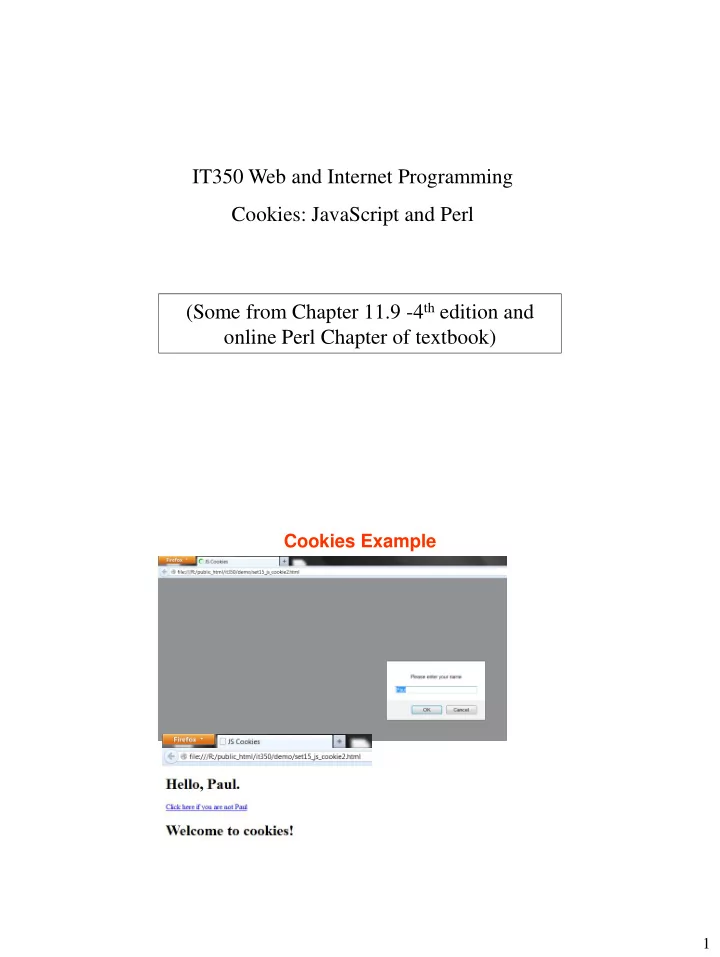

IT350 Web and Internet Programming Cookies: JavaScript and Perl (Some from Chapter 11.9 -4 th edition and online Perl Chapter of textbook) Cookies Example 1
JavaScript: Using Cookies • Cookie – Data stored on _____________ to maintain information about client during and between browser sessions – A string: identifier=value pairs separated by ; – Can be accessed through document.cookie property – Set expiration date using expires keyword – Use escape function to convert non-alphanumeric characters to hexadecimal escape sequences – unescape function converts hexadecimal escape sequences back to English characters Storing Cookies – Simple Version document.writeln("<br/>Cookie is: "+document.cookie); document.cookie = "name=" + escape("J Smith"); document.writeln("<br/>Cookie is: "+document.cookie); document.cookie = "rank=" + escape("Captain"); document.writeln("<br/>Cookie is: "+document.cookie); 2
Reading Cookies – Simple Version myCookies = document.cookie; cookieElements = myCookies.split("="); document.writeln( "<br/>Identifier stored is: "+ cookieElements[0] + "<br/>Value stored is: " + cookieElements[1]); Simple Cookie Example // reset the document's cookie if wrong person function wrongPerson() { // reset the cookie document.cookie= "name=null;" + " expires=Thu, 01-Jan-95 00:00:01 GMT"; // after removing the cookie reload the page to get a new name location.reload(); } // determine whether there is a cookie if ( document.cookie ) { var cookie = document.cookie; var cookieTokens = cookie.split( "=" ); // set name to the part of the cookie that follows the = sign name = cookieTokens[ 1 ]; name = unescape(name); } else { // if there was no cookie then ask the user to input a name name = window.prompt ( "Please enter your name", “Paul" ); document.cookie = "name=" + escape( name ); } document.writeln("<h1>Hello, " +name + ". </h1>" ); document.writeln ( “<p><a href = ‘ javaScript:wrongPerson ()’ > " + "Click here if you are not " + name + "</a></p>" ); 3
Exercise #1: JS: Ask user for favorite quote using a window prompt. Save quote in a cookie identified by “favQuote”. Display quote on the page. Storing Cookies – More Realistic • By default, cookies expire when session ends • Set “expires” attribute to make stick around longer function createCookie(identifier,value,days) { if (days) { var date = new Date(); date.setTime(date.getTime()+(days*24*60*60*1000)); var expires = "; expires="+date.toGMTString(); } else var expires = ""; document.cookie = identifier+"="+escape(value)+expires; } function eraseCookie(identifier) { createCookie(identifier,"",-1); } (modified from http://www.quirksmode.org/js/cookies.html) 4
Reading Cookies – More Realistic // Return the 'value' of the cookie with identifier 'desiredId' // returns null if no match found. function readCookie(desiredId) { // First split the pairs apart on '; ' var pairs = document.cookie.split("; "); // Now split each pair on '='. Check if have a match for (var i=0; i < pairs.length; i++) { var aPair = pairs[i]; // split into desired parts and check for match var cookieTokens = aPair.split("="); var id = cookieTokens[0]; var value = cookieTokens[1]; if (id == desiredId) { // found desired cookie -- return value return unescape(value); } } return null; // no match } Exercise #2: JS: Read the value of cookie identified by “favQuote” and display it in a pop -up msg if it exists, otherwise display “no quotes” 5
Exercise #3: Re-write Simple Cookie Example using the helper functions Cookies – Java Script and Perl • Cookies with JavaScript – Create cookie • document.cookie = “color=red”; – Read cookie (from JavaScript) • Read and parse document.cookie • Use readCookie() function to help with this – Where are cookies stored?? • Cookies with Perl – Create cookie with print() BEFORE printing header() • Sent to browser – Browser always sends appropriate cookies back to server with request – Read cookie • Access $ENV{ “HTTP_COOKIE” } (book does this) • Or use cookie() function helper (easier!) – Where are cookies stored?? • Cookies created with Perl can be read via JavaScript and vice versa 6
Create Cookies with Perl (Assume this file invoked from a HTML form with fields name, height, and color) #!/usr/bin/perl use strict; use CGI qw( :standard ); use CGI::Carp qw(warningsToBrowser fatalsToBrowser); my $name = param( "name" ); my $height = param( "height" ); my $color = param( "color" ); my $expires = gmtime( time() + 86400 ); print "Set-Cookie: Name=$name; expires=$expires; \ n“; print "Set-Cookie: Height=$height; expires=$expires; \ n“; print "Set-Cookie: Color=$color; expires=$expires; \n"; print header(); print start_html( ); print h1(“3 cookies were stored! Name: $name, Height: $height, Color: $color"); print end_html(); Read Cookies With Perl #!/usr/bin/perl use strict; use CGI qw( :standard ); use CGI::Carp qw(warningsToBrowser fatalsToBrowser); print header(); print start_html( ); my $name = cookie( "Name" ); my $height = cookie( "Height" ); my $color = cookie( "Color" ); if ($name || $height || $color) { print h1("A cookie was found!"); print h2("Name: $name"); print h2("Height: $height"); print h2("Color: $color"); } else{ print h1("Could not find cookies for Name, Height, or Color"); } print( end_html() ); 7
Uses for Cookies • Most common: – User logs in using secure page (https) – Server checks password. If good, creates cookie • E.g. “ login=m168987&auth=356af12cd124552 ” – User redirected to other pages. These pages don’t ask for password – instead just check that have valid login cookie – Why do we need the auth field? Exercise #4: Perl: a) Create a cookie with identifier “ favQuote ” and content “DTT/FSA” b) change your program to store the quote provided by user (not hardcoded) through CGI – param name “quote” 8
Remember • Relevant cookies always sent by browser to the server • Can create with JavaScript and read with Perl • Or create with Perl and read with JavaScript 9
Recommend
More recommend